Zero Gravity is a decentralized AI operating system designed to advance the intersection of AI and blockchain applications. Zero Gravity provides the infrastructure to enable the development and use of AI to be infinitely scalable and decentralized at the core level, including storage, computing, data availability, and reasoning. The platform is designed to address many of the limitations of centralized AI systems, including high costs, data ownership issues, and lack of transparency.
The upcoming Zero Gravity Foundation Node Sale in November 2024 is a critical step in the development of the project. This sale has two main purposes: to build a distributed network environment and to allow the community to directly participate in the development of the project through infrastructure ownership. Zero Gravity hopes to make the infrastructure public through this node sale, allowing community members who purchase aligned nodes to verify AI workloads, protect network security, and contribute to the overall health of the Zero GravityAI ecosystem.
introduction
background
Zero Gravity ( 0G ) is a decentralized AI operating system that provides the infrastructure needed to decentralize and scale core AI components (compute, storage, data availability, and reasoning). 0G s solution provides answers to several challenges of centralized AI systems, such as barriers to entry due to high operating costs, lack of transparency due to closed-source systems, and privacy issues caused by centralized control of data.
Using blockchain technology as a support, 0G provides users with a fairer AI platform, enabling individual developers, companies and consumers to build and use AI applications on a distributed, scalable and open system. To achieve this goal, the 0G ecosystem consists of several key components, including:
Decentralized storage network
Data Availability Layer ( 0G DA)
Modular architecture for enhancing AI workflows
Upcoming decentralized service network for AI inference
These components combined together give 0G the ability to manage on-chain AI-enabled infrastructure, opening up development opportunities for a wide range of industries.
Purpose of Node Sales Report
The sale of 0G AI alignment nodes is scheduled to officially take place in November 2024. Through public node sales, 0G will drive AI ownership from centralized large enterprises to a global decentralized network.
The Aligned Node Sale is designed to empower community members, developers, and operators to directly participate in the 0G ecosystem by purchasing and operating AI Aligned Nodes.
The 0G Alignment Node is responsible for verifying key operations in the network, including:
Check the status of storage, data availability (DA), validators, and service nodes
Transaction Processing
Data availability
AI model calculation
In other words, node operators are directly responsible for ensuring the overall security, scalability, and efficiency of the entire 0G system. They will make direct contributions to all AI workflows running on 0G and be compensated through an internal reward system, where node operators will earn native tokens and other rewards for their contributions to the workflow.
The main purpose of this report is to provide a comprehensive analysis of the upcoming node sale, highlighting its significance to the long-term development and sustainability of the platform. Specifically, this node sale brings two key advantages:
Strengthening the decentralization of the 0G ecosystem by increasing the number of participants actively participating in network operations.
Promoting community-driven infrastructure ownership, ensuring that platforms are governed and maintained by diverse stakeholders rather than centralized players.
The Importance of AI Alignment Nodes
AI alignment nodes are an innovation in the decentralized AI space that are designed to ensure that other nodes in the 0G network, such as validation nodes, storage nodes, and computing nodes, comply with network protocols and operate normally. Initially, these nodes will focus primarily on verifying AI workloads, but as the platform develops, they will take on more important tasks, including monitoring the drift of on-chain AI models to ensure that AI systems remain transparent and in line with network goals.
The Current State of Web3 and the AI Ecosystem
The Current State of Decentralized AI and Blockchain
As of 2024, the intersection of blockchain and AI is mainly divided into three major areas: infrastructure, resources, and problem solving. Networks such as NEAR, TAO, and Fetch.ai provide platforms for decentralized AI development and incentivize developers through tokens. Projects such as Render and Akash provide access to idle GPU resources, while Filecoin and Arweave provide decentralized storage solutions, reducing dependence on centralized systems. Finally, protocols such as Worldcoin, Origin Trail, and Numbers Protocol are committed to solving AI challenges such as forgery and false information, focusing on the transparency and security of AI-generated content.
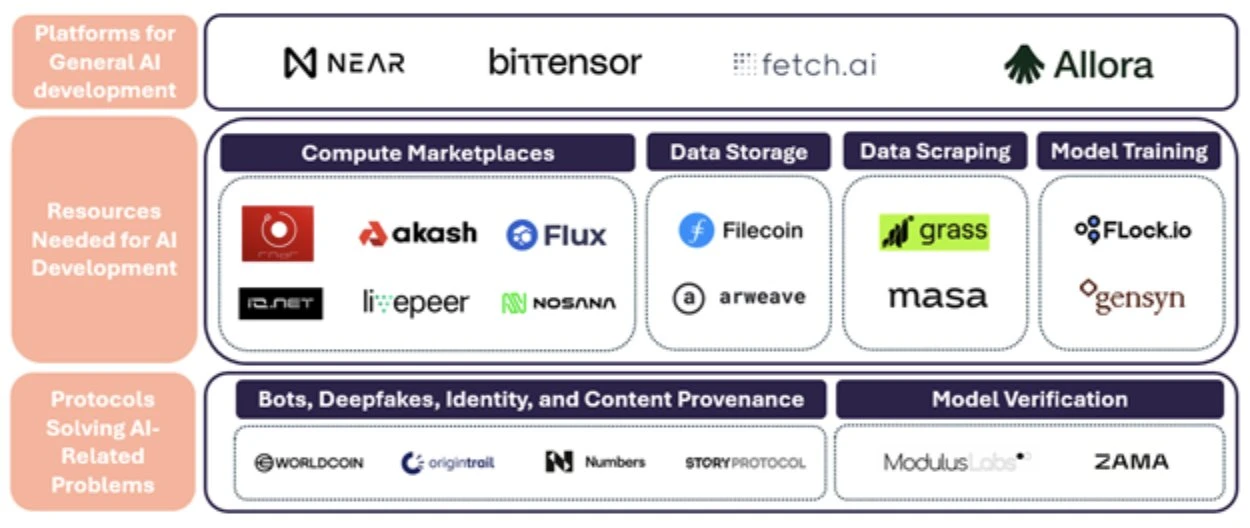
Challenges and risks of centralized AI systems
The current AI infrastructure is centralized, leading to issues with data ownership, transparency, and fair profit. 0G s goal is to decentralize AI, giving users full control over data and ensuring transparency in the decision-making process. 0G coordinates distributed resources (such as storage and computing) through blockchain to build a scalable and auditable AI infrastructure. Its modular system can be integrated with any workflow, making it possible to deploy decentralized AI on-chain.
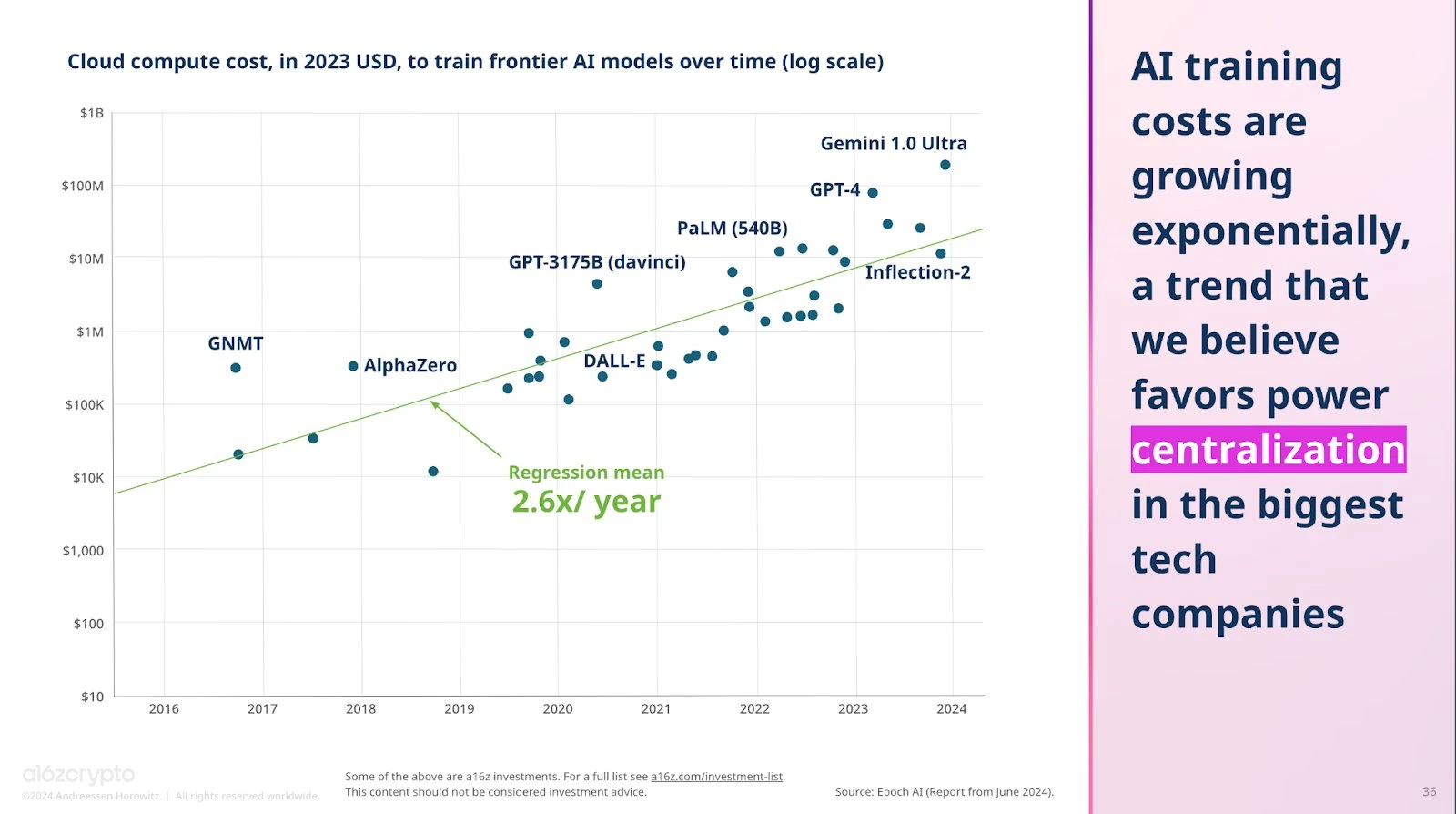
Centralized AI has problems with data control, transparency, profit distribution, and governance. 0G ’s decentralized approach addresses these issues in four ways:
Ownership: Unlike centralized systems that may misuse personal data, 0G allows users to retain control of their data on decentralized networks.
Transparency: Centralized AI lacks transparency, while 0G ensures open and verifiable operations through decentralized data management.
Profitability: Centralized AI concentrates profits in a few entities, while 0G promotes fair returns for all contributors.
Governance: 0G provides decentralized supervision to ensure transparent processes and shared incentives for participants.
The need for decentralized AI solutions
Blockchain-based decentralized AI disperses ownership, governance, and control, making AI more transparent and ubiquitous, promoting competition and innovation, and weakening the dominance of large technology companies. However, there are still some key challenges to achieving true decentralization:
Who builds the model?
Who owns the data?
Who provides the resources?
Who develops AI products?
Market opportunities and growth potential
The convergence of blockchain and AI brings powerful synergies that cannot be achieved with centralized systems. Web3 enables trustless coordination among distributed participants, opening up new ways to address AI challenges in data, computing, and governance.
To build and run AI models, you need three key components:
Model Architecture
High-quality data
Computing power (such as GPU)
Web3 is transforming these areas through tokenization of data systems, decentralized computing, and antitrust efforts.
Current Status of 0G Ecosystem
The 0G ecosystem covers different projects in multiple industries, including games, DeFi, and various blockchain infrastructures. On the supply side, 0G s infrastructure has interoperability with projects such as Brevis and Axelar for cross-network data integration, as well as re-mortgage solutions such as EigenLayer, and decentralized GPU computing power support provided by IoNet and Aethir.
On the demand side, the application of AI projects, blockchain networks, and gaming platforms is growing rapidly. Major players such as Polygon and Arbitrum have taken advantage of 0G s data availability solutions, while Web3 infrastructure providers such as Caldera and Gelato have integrated 0Gs services to enhance their platforms. Game developers like Blade Games have also used 0G s decentralized storage to enable trustless on-chain gaming environments and real-time, verifiable game states.
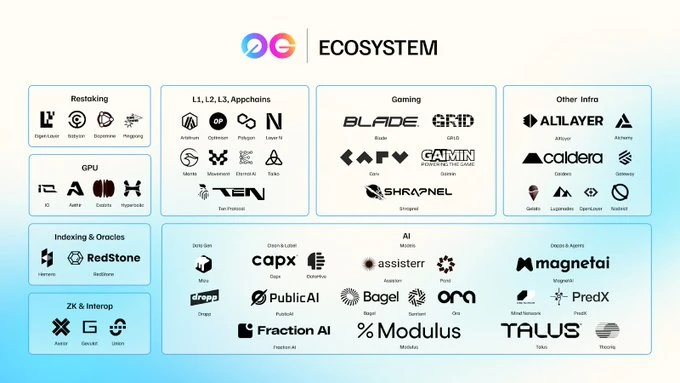
0G Technology Overview
Decentralized AI operating system
Operating systems (OS) are key tools for managing computer hardware and software, such as Windows, macOS, and Linux. Before the advent of operating systems, computers required manual operation and the process was very complicated. The advent of operating systems such as Windows, Linux, macOS, and Android has greatly simplified hardware management and application operation, allowing users to run programs efficiently, manage memory, and automate processes.
Historically, early computing systems had to be operated manually, which hindered the widespread use of computers. It was not until 1956 that IBM developed the first operating system, which was specifically used for task scheduling, memory management, and batch processing. Similar to the efficiency changes brought by traditional operating systems to the computing field, 0G is committed to bringing transformational changes to the decentralized AI field. For decades, AI development has been limited to a few technology giants that can afford the infrastructure and have the ability to manually build systems.
Why do we need an operating system for AI?
The operating system simplifies hardware interactions and standardizes processes, facilitating easier development and innovation. In most AI systems, development is done on proprietary platforms, which limits competition and centralizes control. 0G s decentralized AI operating system (dAIOS) changes this by decentralizing the underlying infrastructure of AI applications.
0G s dAIOS is unique in that it redesigns the entire operating system, introducing a decentralized, infinitely scalable and modular operating system that changes the way AI is deployed and managed at every level, from storage and computing to governance and economic incentives.
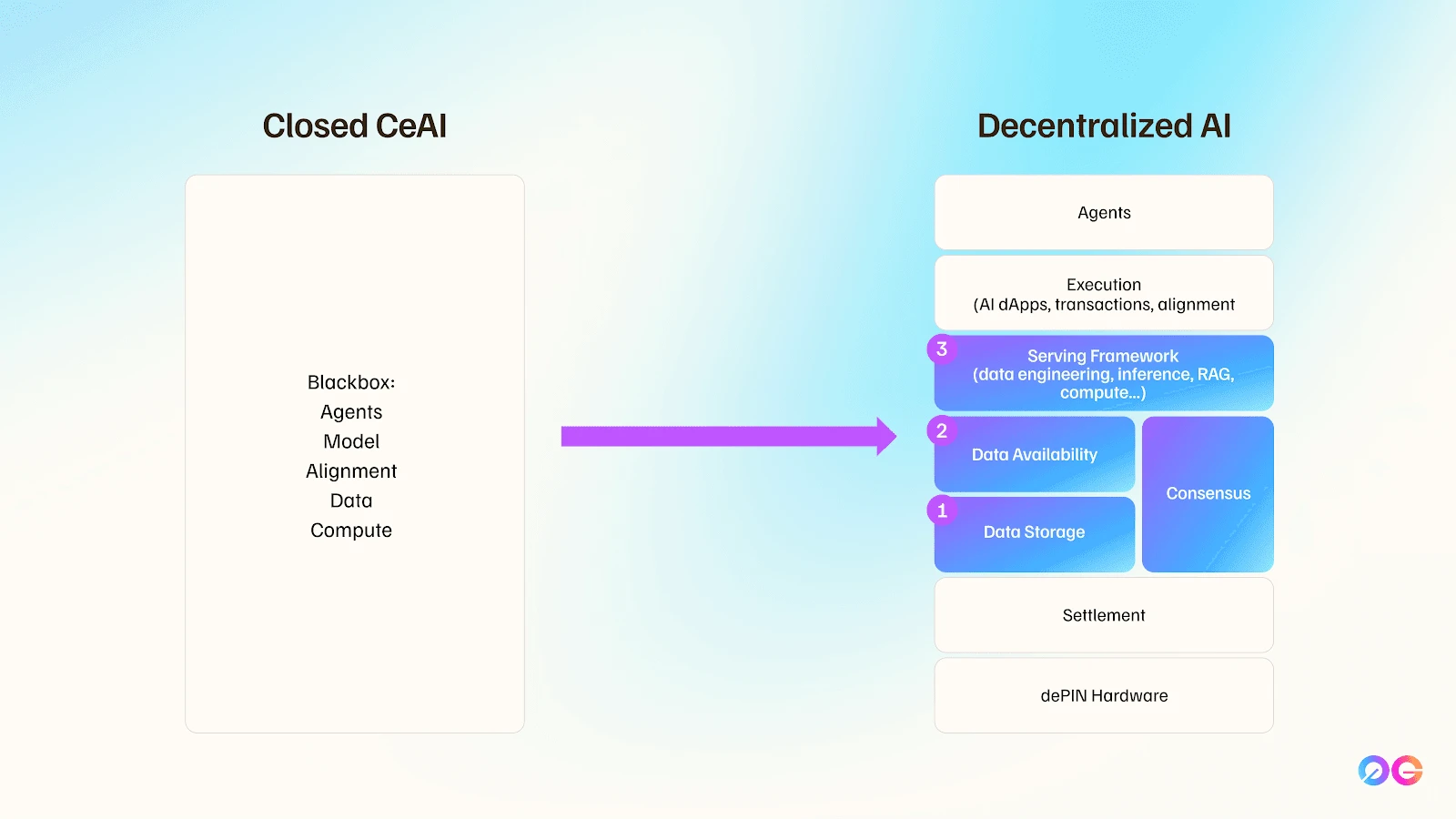
Core Innovation of 0G
0G storage
0G Storage is a fundamental component of 0G OS, a decentralized and scalable database for Web2 and Web3 environments. Its storage infrastructure is capable of handling large-scale data loads, including large data sets, AI models, and generated assets for machine learning workflows. Its design guarantees high throughput and reliable performance, suitable for applications with high data demand.
0G storage uses a technology called erasure coding to divide data into multiple smaller redundant fragments and spread them across the storage network to ensure that data can be accessed even in the event of a failure or network interruption.
To verify the integrity of the data and ensure that nodes are actively maintaining the network, 0G uses a Proof of Random Access (PoRA) mechanism. PoRA requires miners to prove that they store a specific block of data through random queries. Miners are rewarded based on their ability to respond to these queries, thereby ensuring decentralized participation and security. Erasure coding technology allows fault tolerance and efficient storage, and when data is lost or corrupted, only a portion of the data fragments need to be accessed for rapid recovery. This design allows 0G to handle the high data volume requirements of AI models and dApps with extremely low latency.
Service Module
0G s service module introduces a decentralized framework that changes the way AI services are accessed and delivered. It connects users who need AI model inference and GPU owners who run these models, creating a direct, trusted market without intermediaries. Service providers can set their own prices and receive rewards in real time based on their contributions, providing a transparent, efficient and accessible alternative. The open ecosystem allows anyone with hardware to participate, building a global network of service providers to make advanced AI services accessible to a wider range of users at a lower cost.
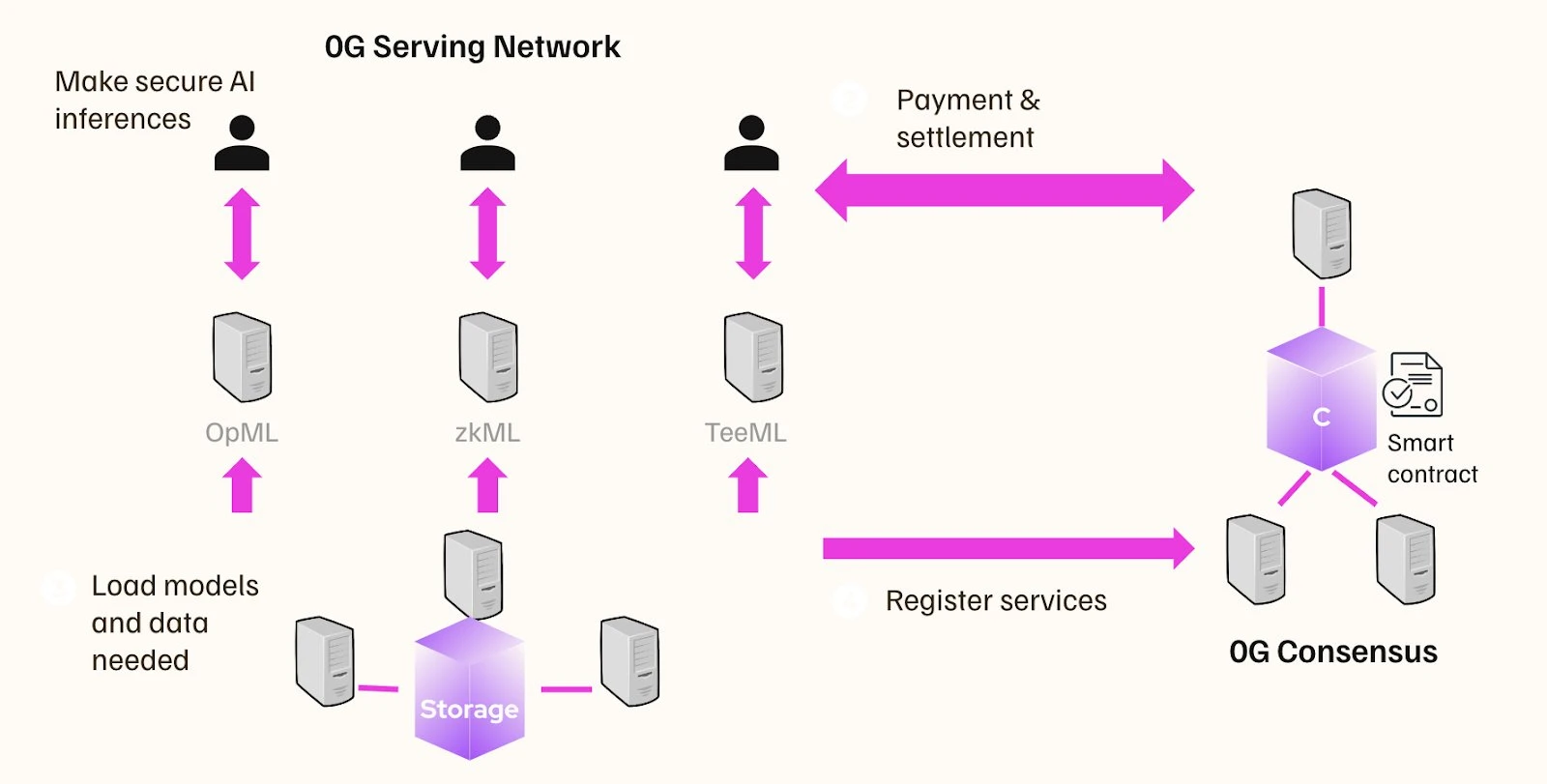
The platform is designed with a focus on performance and ease of use, reducing on-chain transaction costs by allowing service providers to batch multiple user requests, while utilizing zero-knowledge proofs (ZK-proofs) to compress data to optimize settlement. In addition, through 0G Storages off-chain data management, large-scale data sets can be processed efficiently and costs can be reduced. The interaction between users and providers is seamless, and smart contracts manage all processes from payment to service execution. Users can deposit funds in advance to access services, and a built-in refund mechanism allows users to retrieve unused balances within a specified time. Through decentralized service delivery and payment processes, 0G s service module provides a scalable, user-friendly alternative that redefines the way AI workflows are monetized and deployed.
0G Data Availability (DA)
0G DA provides consistent data accessibility in a decentralized network by randomly selecting nodes for data verification using a Verifiable Random Function (VRF), thereby preventing collusion and ensuring security. It leverages KZG polynomial commitment technology to efficiently verify data without exposing sensitive information, thereby guaranteeing the integrity and origin of the data. 0G has nearly unlimited scalability to meet the growing needs of AI applications and rollups, etc., and avoid performance bottlenecks. Its dual-channel architecture improves efficiency with a data storage channel for fast and secure transmission and a data publishing channel that ensures continuous availability. Performance is further optimized through GPU-accelerated erasure coding.
Security and scalability mechanisms
0G consensus mechanism
A major feature of 0G is its ability to scale horizontally through multiple independent consensus networks. These consensus networks can be deployed on demand, even in the thousands, allowing the system to scale as needed. Each network operates independently, managing data commitments and ensuring the integrity of stored data. This modular approach ensures near-infinite scalability.
In the 0G system, data is partitioned into multiple networks, and each partition can be processed independently and in parallel. This architecture not only improves performance, but also enables the efficient processing of large amounts of data such as those required for real-time AI model training. By distributing data to different partitions and managing them through independent consensus networks, 0G ensures that its infrastructure can scale with the growth of decentralized AI platform needs.
Shared staking mechanism
Another innovative feature of the 0G architecture is the shared staking mechanism across all consensus networks. Validators stake 0G tokens on the Ethereum mainnet and use these staked assets to verify data in each 0G consensus network. When participating in consensus on any 0G network, validators rely on the same staked assets, ensuring unified security across the entire ecosystem.
In addition, tokens can be destroyed on the 0G network and redeemed on Ethereum, building a fluid cross-chain system with enhanced security and liquidity. This shared staking design avoids the need for separate staking for each consensus network, improving system efficiency while ensuring that validators have consistent incentives across all networks, prompting them to behave honestly across all networks.
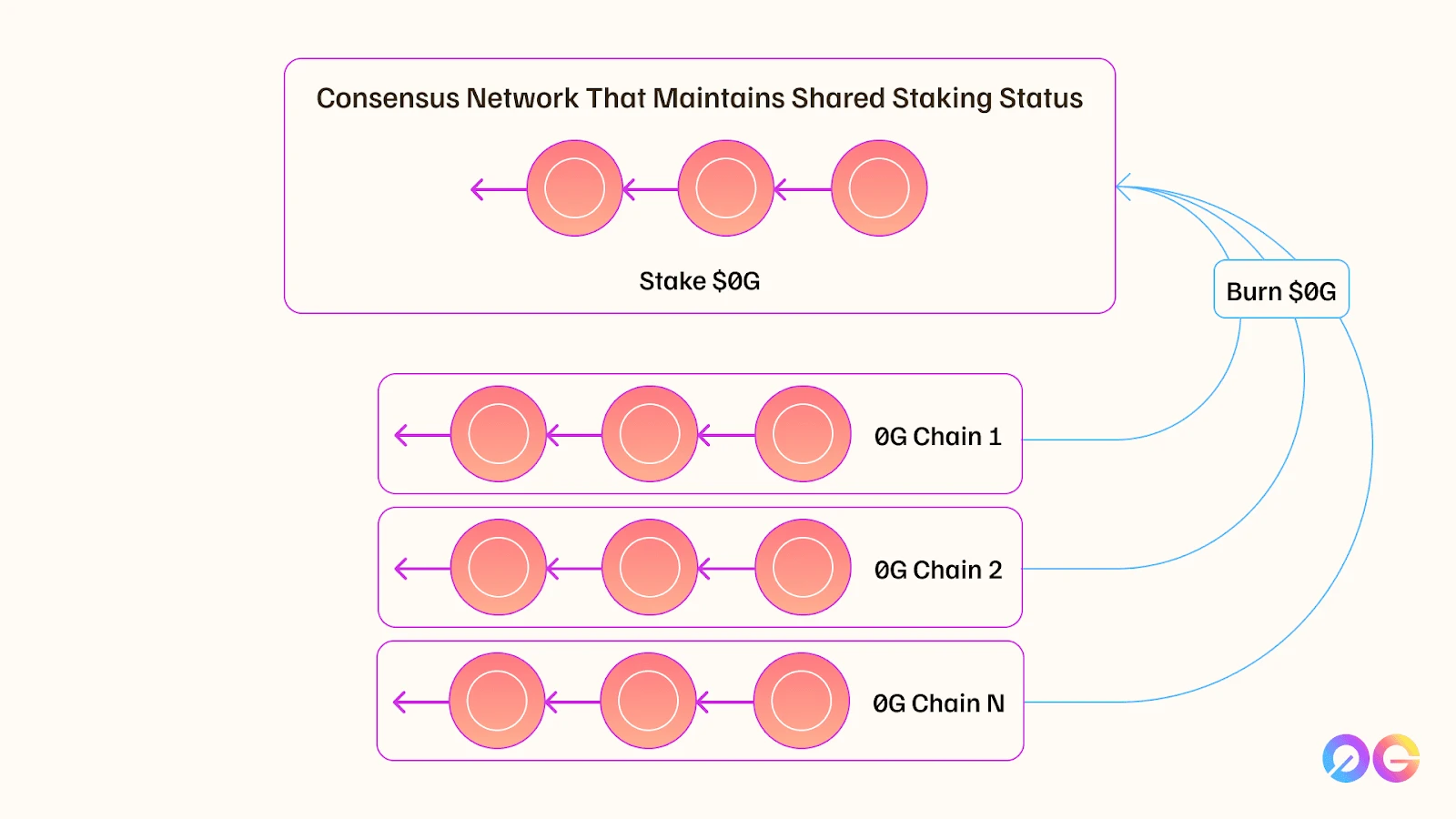
0G s Higher Goal: AI Aligned Nodes and the Future of AI
The AI alignment nodes in the 0G network are designed to ensure that the behavior of AI models deployed within the system complies with established ethical standards and operating guidelines. They monitor the operations of other decentralized nodes (such as verification nodes, storage nodes, and service nodes) to ensure compliance with network protocols. These nodes will serve as a lightweight monitoring tool in the early stages, but are expected to gradually expand their functionality. In the future, they will be responsible for monitoring the behavior of on-chain AI models, tracking deviations, and ensuring that AI systems operate as expected.
Preventing AI bias and loss of control
In decentralized systems, AI alignment nodes help monitor and prevent bias or runaway behavior in AI models. They track the behavior of models in real time, detect deviations, and sound alerts when necessary to ensure that models remain accurate and perform their intended functions. In centralized AI systems, problems may not be discovered until they have caused an impact. 0G s decentralized AI system uses alignment nodes for real-time monitoring, detects problems in advance, improves system reliability, and enhances the trust of users and developers.
Future functions and responsibilities
As 0G networks develop, AI-aligned nodes will take on more advanced tasks:
Drift monitoring: Track AI models to ensure their behavior is consistent with their initial training to prevent bias or incorrect outputs.
Risk control: Continuously check the output of the model to ensure the reliability of the decentralized AI model.
Cross-chain governance: Coordinate governance on decentralized chains to maintain ethical standards across the ecosystem.
0G Node Sales
The 0G node sales are divided into two phases:
Whitelist node sales start: November 11, 2024 12:00 UTC, only for whitelist users, lasting 2 days.
Public Node Sale Launch: November 13, 2024 12:00 UTC, open to all users.
This tiered approach ensures priority participation for early community members while allowing broader user participation after the whitelist period.
Node specifications, prices, and allocations
0G node sales total 175,500 nodes, divided into 32 levels, with a starting price of 0.05 ETH. Each level provides a certain number of nodes, and low-level nodes provide a lower purchase threshold for early users and the community.
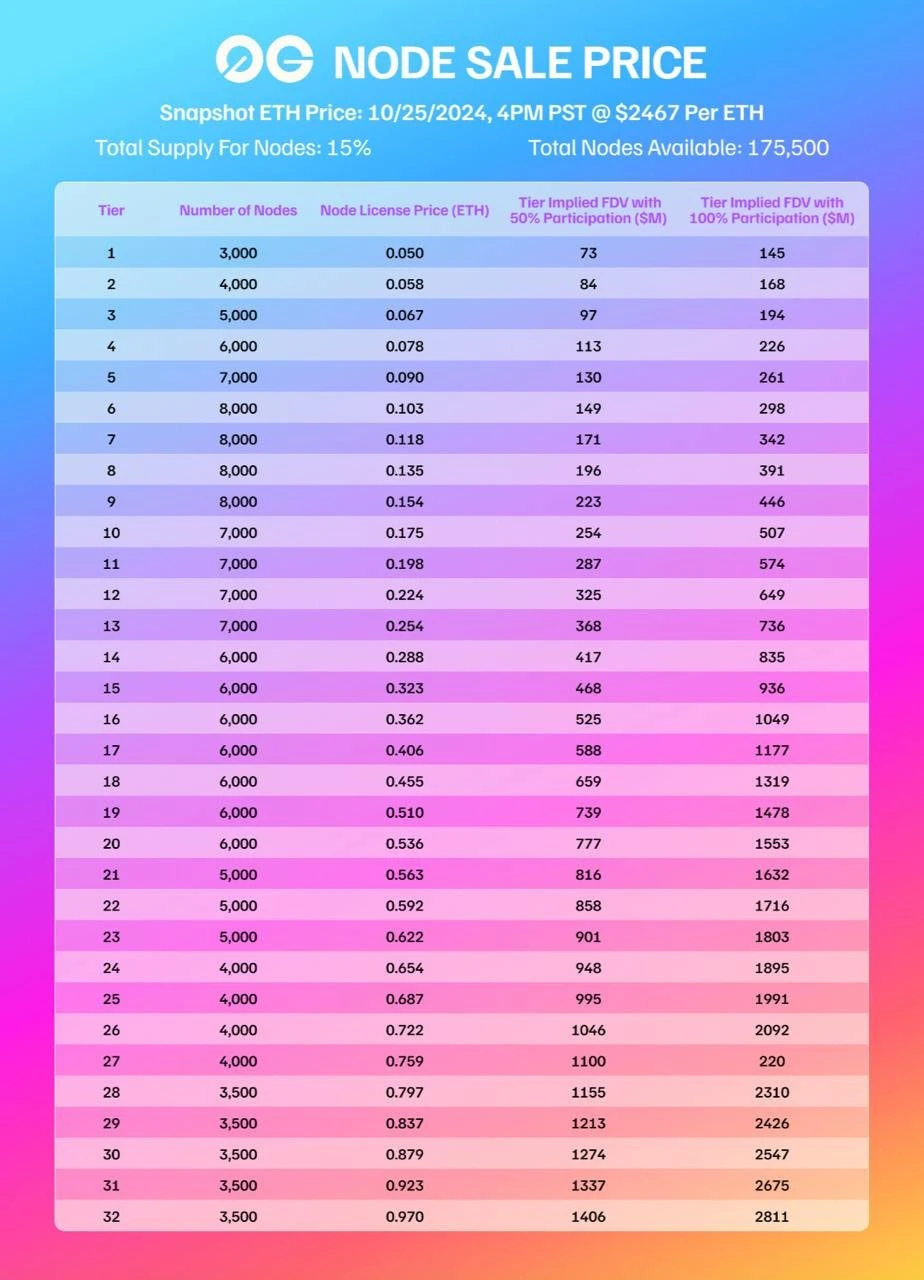
Minimum node hardware requirements:
64 MB RAM
1 x 86 CPU core @ 2.1 GHz
10 GB storage
10 Mbps Internet connection
Supports payment methods of multiple blockchains
In order to adapt to different blockchain ecosystems, 0G node sales support multiple token payments on EVM-compatible chains and Solana. For details, see: Chain Options .
Purchase Process and NFT Licensing
Purchase steps:
Visit node.0 gfoundation.ai and connect your wallet.
Select a payment chain and a payment token.
Review the available tiers and select the desired number of nodes.
Optionally use promo codes to get discounts.
Approve the transaction in your wallet and complete your purchase.
A few weeks after purchase, buyers will receive an ERC-721 NFT representing ownership of their 0G node. These NFTs are non-transferable during the first year but provide lifetime access to the 0G network. Nodes will be activated after the 0G mainnet launch, expected in Q1 2025, at which time node operators will begin to receive rewards.
Early Participation Advantages
Early operators who participate in the 0G node sale will gain a strategic advantage, especially as the decentralized AI platform continues to expand in industries such as finance, healthcare, and autonomous systems. Early participants will receive a lifetime node license, allowing them to continue to participate in the growth and development of the platform.
Ecosystem Rewards and Incentives
One of the attractions of the 0G node sale is the long-term reward structure for node operators. Operators will be eligible to receive 15% of the total supply of 0G ecosystem tokens over the next three years.
The distribution of these rewards includes:
Ensure data integrity: Aligned nodes will verify the accuracy of AI computations, data storage, and data availability, maintain the integrity of AI workloads, and may also detect malicious data injections to prevent the training of decentralized LLM models from being affected.
Supporting network security: Nodes contribute directly to the decentralization and security of the network, ensuring that no single entity can control the platform.
Lifetime access and non-transferable NFTs
Lifetime access to the 0G network is a significant benefit for node sale participants. Each node purchase corresponds to an ERC-721 NFT, which symbolizes ownership and provides the operator with lifetime access to the 0G platform. These NFTs are non-transferable within the first year after the sale to ensure that node operators are truly committed to the growth of the ecosystem, thereby building a more stable and secure network.
Strategic Advantages
For strategic operators, 0G node sales offer unique opportunities, especially at the intersection of AI and blockchain:
Cross-chain diversification: Node sales support payments on multiple EVM-compatible chains and Solana, and operators can use assets from their preferred ecosystem.
Scalability and future-proofing: The 0G platform is designed to be infinitely scalable and can support the growing data requirements of AI models.
Potential network effects: As more operators, developers, and users join the 0G ecosystem, the economic utility of the platform will continue to increase due to network effects.
Community participation and recommendation incentives
0G incentivizes community-driven growth through a referral program, allowing node operators to earn 5-10% cashback on every successful referral.
Buyers who successfully refer new buyers to participate in the node sale will receive approximately 5-10% USDC cashback, and buyers who use the referral code can receive an additional 5% rebate. This feature not only rewards active community members, but also encourages natural growth within the ecosystem.
Rebates and commissions will be distributed via USDC airdrops, which are expected to be distributed approximately six weeks after the sale. This provides additional incentives for early operators who actively participate in expanding the 0G community.
Importance of Node Sales to the 0G Ecosystem
The 0G node sale is a critical moment for the project to expand the decentralized AI space and provide a launchpad for innovative development. By distributing nodes to a wide range of participants, 0G will become a community-driven effort - it all starts with the purchase and distribution of nodes, especially aligned nodes.
As mentioned above, node operators will be the core of the 0G decentralized AI operating system (dAIOS). They play a fundamental role in verifying transactions, maintaining data integrity, and providing the computing power required to support AI computing, which involves almost all operations of the decentralized AI operating system.
Risk Analysis
Technical risks
There are some technical risks in operating in a decentralized AI ecosystem like 0G . First, as with any emerging technology, fluctuations in usage may affect the economic utility of the 0G ecosystem, especially in the early stages of decentralized AI.
Furthermore, despite 0G’s strong infrastructure, the rapid development of AI and blockchain technologies may bring unforeseen challenges and competitors. Competing platforms may develop similar innovations, which could affect 0G ’s market share (although market first-mover advantage helps mitigate this risk). In addition, as the network grows, scalability and performance issues may arise (as with any new platform), which will require continuous updates and improvements over time.
Regulatory and compliance considerations
Operating in the decentralized AI space means navigating a complex regulatory landscape:
Regulatory uncertainty: AI and blockchain are areas of increasing regulation around the world. Changes in AI governance or blockchain regulations could impact the operational or compliance status of 0G nodes, particularly in relation to data privacy, AI, and ethics.
Compliance with data privacy laws: Since 0G involves data storage and processing, it may need to comply with data privacy regulations such as GDPR in Europe and CCPA in the United States. Ensuring compliance with these ever-changing standards is critical to maintaining legal stability.
Risk Mitigation Strategies and Safeguards
0G takes a number of steps to ensure these risks are appropriately mitigated. First, by distributing the decision-making process across a network of node operators, 0G reduces the risk of failure driven by centralized authorities. Furthermore, decentralized governance and ownership help mitigate compliance issues or failures.
Additionally, 0G ’s modular infrastructure can be updated seamlessly when upgrades, changes, or advancements are needed. This means that 0G will become a highly dynamic platform that can stay competitive and relevant in the AI space.
Summarize
The 0G platform has launched the worlds first decentralized AI operating system (dAIOS), providing scalable, low-cost infrastructure and enabling decentralized governance. By supporting unlimited scalability and efficient AI workload processing, 0G has positioned itself at the forefront of decentralized AI technology. Operators will have the opportunity to participate in the node sale that will be launched in November 2024 and gain early access to AI-aligned nodes that are critical to network operations and governance.
Node operators will receive significant benefits, up to 15% of the total supply of 0G tokens over the next three years. These nodes also provide lifetime access to the platform and are presented as non-transferable NFTs during the first year, ensuring exclusive participation without secondary market speculation. Payments will be accepted from multiple blockchain ecosystems, including Ethereum, Solana, and Arbitrum, highlighting the platforms emphasis on interoperability and accessibility.
For potential participants, early participation is an effective way to acquire nodes at the lowest price and maximize long-term rewards. Operators will play an important role in verifying workloads and ensuring network security, so continued participation is key to fully utilize the platforms incentive structure. Combined with attractive rewards, cross-chain accessibility, and a cutting-edge decentralized AI framework, the 0G node sale provides an attractive opportunity for participants who are ready to commit to the future of decentralized AI.
Node Sales Participation
For those interested participants who reside in appropriate regulatory jurisdictions, they can apply for whitelisting and prepare tokens in advance.
Community Discord channel: https://discord.com/invite/0g labs
Telegram channel: https://t.me/web3_ 0 glabs
Twitter: https://x.com/0G_labs
Whitelist application: https://docs.google.com/forms/d/e/1FAIpQLScZSiIn3WBEdztzCObFBnLa0c6f1YoRwlN_eI8NxGPuG4w-zg/viewform










